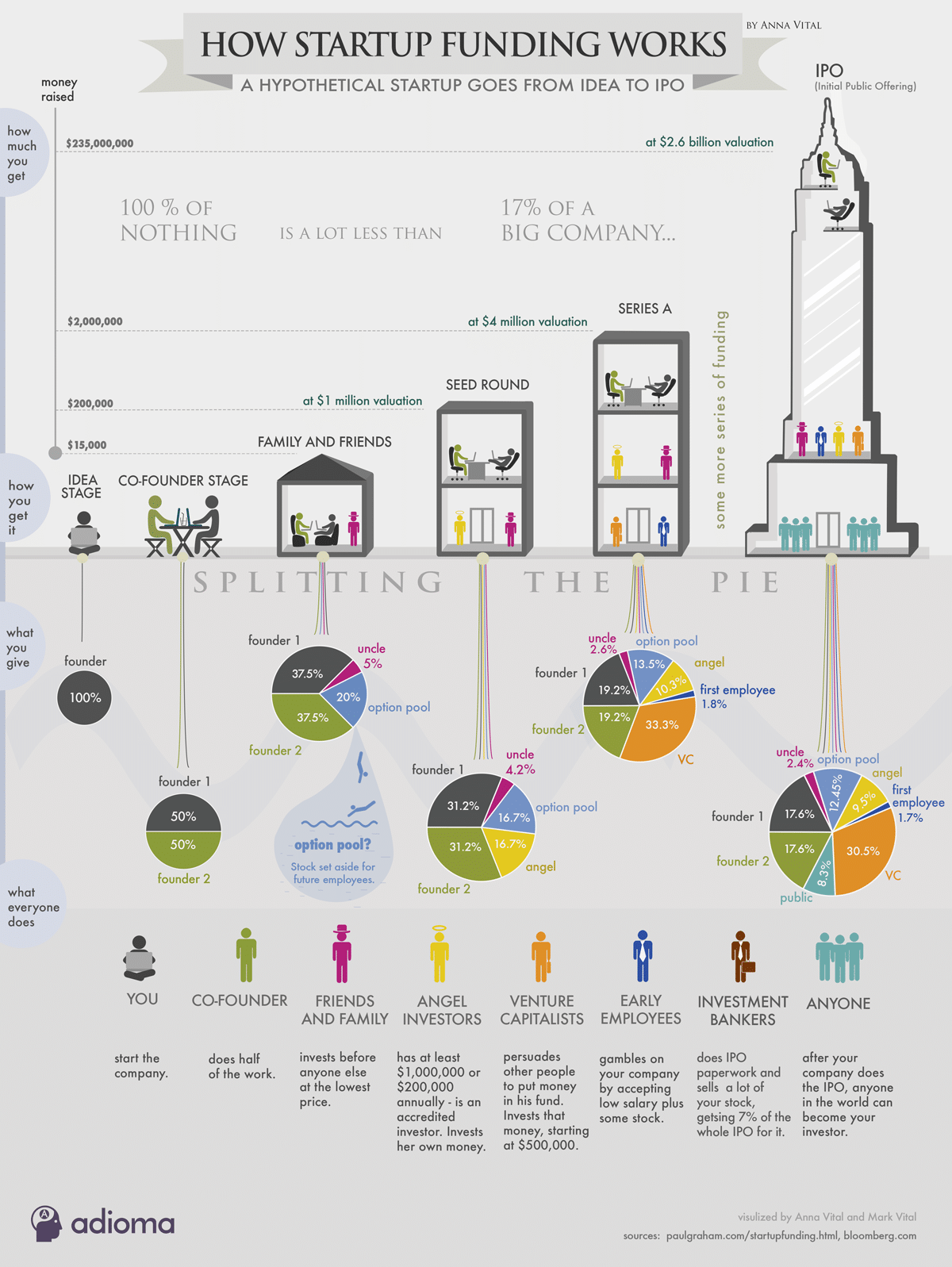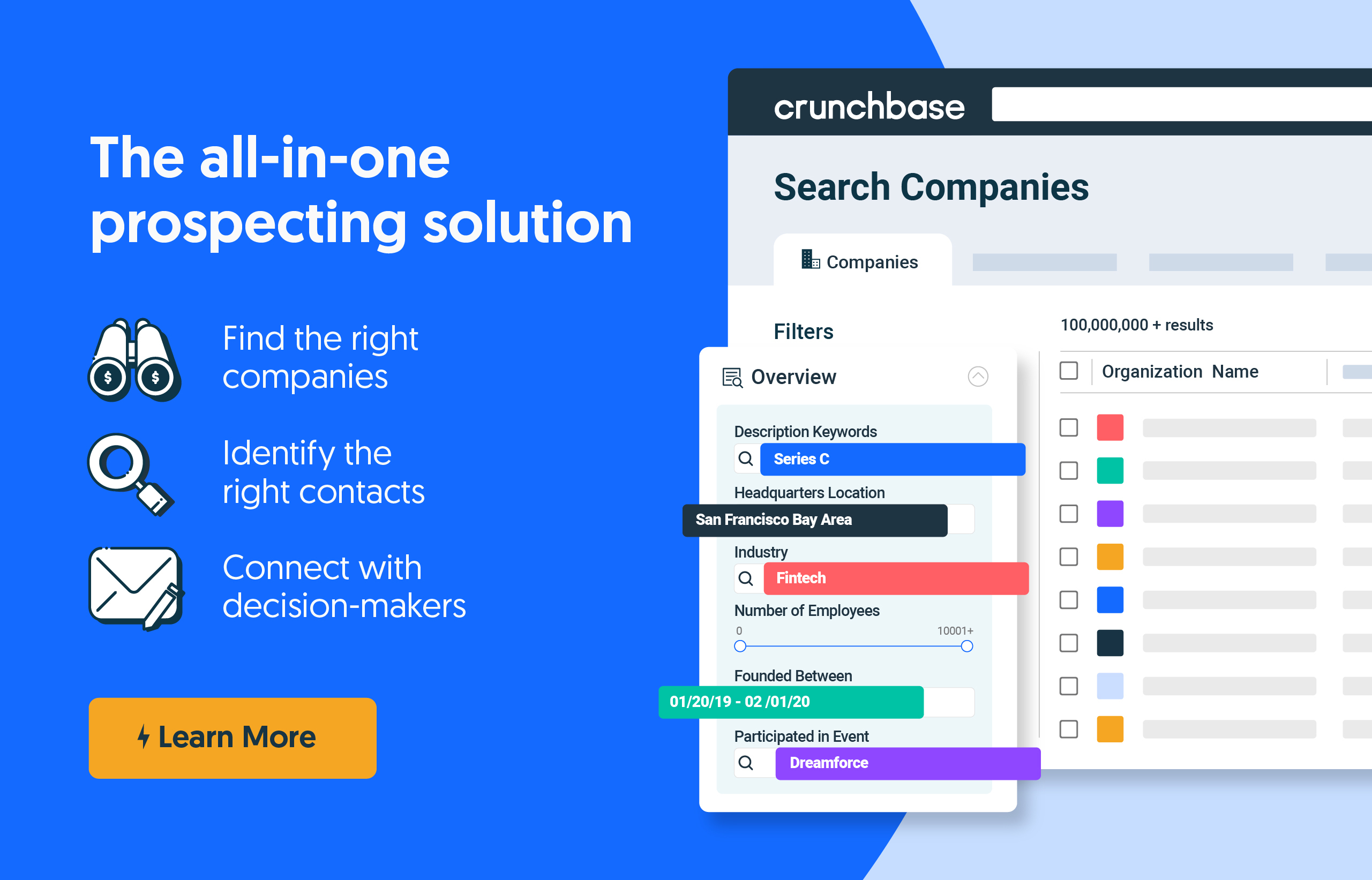In the world of startups, it’s survival of the fittest. According to a Small Business Administration Office of Advocacy study, only 50% survive after five years – and only one-third make it to the 10-year mark. A lack of capital is one of the primary reasons startups fizzle within the first few years, so learning the ins and outs of acquiring money and promoting your company can help ensure a successful business.
Search less. Close more.
Grow your revenue with all-in-one prospecting solutions powered by the leader in private-company data.
What is startup capital?
Startup capital is the seed money that’s raised through investments or bank loans to start a business. This cash can be used for anything business-related, from product development and manufacturing to marketing campaigns and office equipment.
What are startup funding rounds?
Startup funding rounds are a series of investments that raise capital for a new business. As a startup expands and becomes successful, each funding round serves as a stepping stone toward greater growth.
What are the different startup funding rounds?
Funding rounds usually begin with an initial pre-seed and/or seed round, which then progresses from Series A to B, C and beyond. Depending on the type of industry and investors, a funding round can take anywhere from three months to over a year. The time between each round can vary between six months to one year. Funds are offered by investors, usually angel investors or venture capital firms, which then receive a stake in the startup.

Seed-stage funding
Pre-seed funding occurs at the very beginning of a startup when the founders usually invest their own money. Family and friends can also contribute during the pre-seed round when the startup creators are trying to get their idea off the ground. This is followed by a seed funding round.
The seed funding round is when investors, usually angel investors, provide funds before a startup becomes operational. It’s the idea phase of a startup when the founders are trying to perfect their product or service. Seed funding investments can range from anywhere between $10,000 to $2 million dollars.
Well-known seed stage investors include Entrepreneur First, Techstars, Bain Capital Ventures, National Institutes of Health and Y Combinator.
Early-stage funding
Next comes funding rounds A through C (or in some cases, A through D). Round A is focused more on startups that have an actual business model that will elicit an immediate profit. Investors are looking for a high return on investment (ROI). In Round A, startups need to have an actual strategy for taking investments and turning them into long-term growth.
Round A investments can collect $2 million to $15 million. Typically, Round A investors are venture capital firms.
After the development stage, Funding Round B signals growth. At this point, startups are expanding and have a foundation of consumers that is steadily growing. Round B helps startups transition into well-established companies. Round B can generate $7 million to $10 million. However, investments can far surpass that range. The behavior analytics platform Mixpanel raised over $65 million during its Round B, for example.
Some of the biggest investors in the early stage funding rounds include Accel, Sequoia Capital, Tencent Holdings and Insight Venture Capitals.
Late-stage funding
When startups move on to Funding Round C and/or D, it’s to continue expansion at a higher level. These startups are now highly successful, hold a value of at least $100 million and receive upward of $50 million in funding. Round C usually means startups want to further their success by creating new products, acquiring companies or expanding their reach – whether that’s in a new market or location.
Companies in the late stages of funding are typically ramping up for an Initial Public Offering (IPO). Once a company has gone public, startup owners may begin to explore their exit strategy options.
Major investors in the late stage funding rounds include Go-Jek, Bain Capital Ventures, Citigroup, Lightspeed Venture Partners, and Index Ventures.
How to create an investor pitch
Successfully raising money as a startup through funding rounds is dependent on a killer pitch. Having an effective sales pitch is the main catalyst to spur investors to fund your startup. Before you even create your pitch presentation, you must have a thorough understanding of your business, products, and services. Be prepared to answer any questions that come your way. You should also know your industry and what sets your startup apart from competitors.
7 tips to nail your investor pitch
Follow these steps for nailing your investor pitch:
- Keep your presentation within a 20-minute time frame with a total of no more than 10 slides. One of the common mistakes made during a sales pitch is overstuffing a presentation. Stick to three bullet points on each slide or include only a single graphic.
- Ensure that each point is concise and include specific details such as financial projections and outlook on future growth when necessary.
- Clearly state your objective in the first 30 seconds of your pitch. You’ll want to tell your potential investors why they should give your startup money and how their funds can benefit the company.
- Follow the inverted pyramid format for your sales pitch. Start with your broad objective and follow up with steps, details, and evidence to support your claims.
- Use storytelling to make your pitch stand out and give your startup a more personal feel while building chemistry with investors.
- Try including testimonials or real-life examples, if possible.
- Close your presentation with some kind of call to action that encourages potential investors to take the next step.
- Include a question-and-answer portion at the end of the presentation so potential investors can ask any questions they may have about your startup.
What to include in your pitch deck
Creating an effective investor pitch can trip up even the most organized and well-prepared entrepreneurs. For many, fundraising for a startup is an unfamiliar task where they lack meaningful experience. Here are some resources that can provide inspiration for pitch decks and tips for achieving success with investors.
Some resources to help you perfect your investor pitch deck
- Anatomy of a Perfect Sales Presentation – HubSpot
- Investor Deck Template – 500 Startups
- How to Pitch a VC – 500 Startups
- How to Fix Your Shitty Pitch – Crunchbase
- What we learned from designing 200 pitch decks – Sketchdeck
- The 7 Questions A Startup Should Answer in their Fund Raising Pitch – Tomasz Tunguz
- Best Pitch Decks: The Early Stage Pitch Decks Of The Hottest Funded Startups – Forbes
- 8 of the Best Pitch Decks That We’ve Ever Seen – ThinkLions
According to a survey conducted by Slidebean, a panel of venture capitalists and successful entrepreneurs aligned on several must-have slides to include in every pitch deck.
How to find the right investors
As a startup founder or CEO, it’s important for you to know the different types of investors available before seeking funding. Crowdfunding and SBA microloans or microlenders may be the best option if you want greater control of your company. However, if you want a more sizable sum of money, venture capitalists, angel investors and private equity firms are better suited for your needs. Be sure to compile a list of target investors prior to making a pitch so you can ensure you get the capital that best suits your needs.
Venture capitalists
Venture capitalists are part of the private sector and are geared toward businesses that are rapidly expanding, such as tech and medical companies. A single venture capitalist investment can range from $7 million to $10 million. Venture capitalist firms usually play a more active role in startups and receive their ROI from carried interest, a percentage of profits or private equity.
Angel investors
Angel investors, similar to venture capitalists, are from the private sector and are individuals rather than private firms. Investments tend to range between $25,000 and $100,000. Think Mark Cuban, Bonnie Beeman, Simon Murdoch, Carla Fowler, and Dave McClure, who invest in you with the expectation of a high ROI. Angel investors may also choose to play a larger role in your startup and request a seat on your board of directors.
Private equity
Private equity firms or individuals invest in startups or businesses by purchasing shares for partial or total ownership in the company (aka equity). A private equity firm has the capability to buy out your public company, essentially turning it into a private business. Some of the most famous private equity firms are Goldman Sachs, TPG and The Carlyle Group. A private equity firm usually raises funds for investments through large third-party investors such as universities, charities, pension plans or insurance companies.
Crowdfunding
Crowdfunding is different from private investors because it opens up the opportunity for investment to the entire public. You pitch your business idea or product and let people around the world donate money through websites such as Kickstarter, GoFundMe and Indiegogo. Crowdfunding is a hands-off approach to investment when it comes to business operations. While crowdfunding may seem like a grassroots approach, it shouldn’t be underestimated. Filecoin, a cryptocurrency data storage platform, raised $257 million from just one month of crowdfunding.
SBA microloans and microlenders
SBA microloans and microlenders provide smaller investments. The Small Business Administration (SBA), a government entity, offers a program that connects small businesses to private lenders for loans of up to $50,000. Other microlending nonprofits are also available and can offer loans averaging $12,000. Microloans are ideal for small startups in need of seed money. As far as how much input these investors may have, it can vary on a case-by-case basis. If you’re wanting total control of your business, be sure to clearly state your desired business relationship in your loan agreement.

How to close an investor agreement
Even if your sales pitch was flawless and you tracked down the right investors for your startup, all that effort is wasted if you fail to close a deal.
Increase the chances of landing investments by following these 4 steps:
-
Prepare
You need to be able to sell your startup, explaining how investors can benefit from your business. You should have concrete numbers that will better guide your conversation with potential investors. Focus on pitching the growth of your startup. Investors aren’t interested in giving money to startups with no potential for expansion. To be most effective, pitch your financial projections with a clear narrative that ties directly into your overarching story. Never leave your financial insights up for projection.
-
Actively listen and clearly communicate
Listen to all of your investors’ concerns and answer their questions. Be completely transparent and direct in your communication. Voice your expectations in terms of what you’re looking for in a potential business relationship.
-
Compromise
You may have to give up some control of your startup if you desire a large investment. If you don’t want an investor to take a seat on your board of directors, you may want to opt for crowdfunding or bank loans.
-
Set a clear timeline
This will help build a sense of urgency for your investors, which may also get you their investments faster. Set deadlines throughout your communication, from when to set up your initial pitch meeting to following up and closing your deal.
Creating a startup is a risk. But, it’s the entrepreneurs who secure investors that make it successfully through the sea of competition. By focusing on the right type of investor, perfecting your sales pitch and embarking on different funding rounds, your startup could be one of the lucky few that survives.






